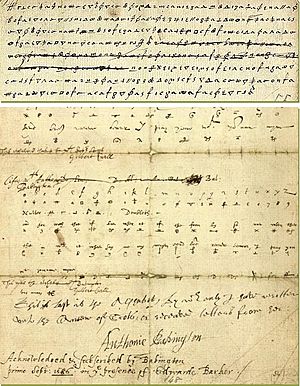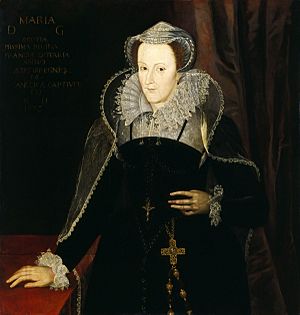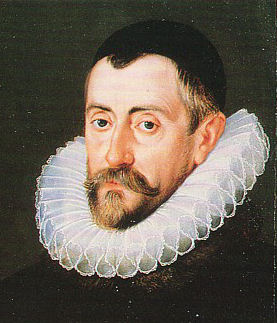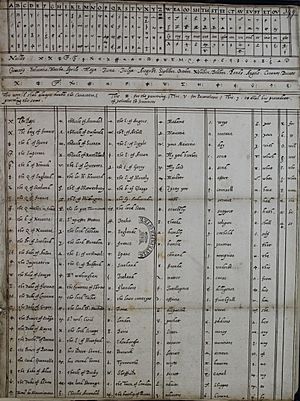Babington Plot facts for kids
The Babington Plot was a secret plan in 1586 to kill Elizabeth I, who was the Protestant Queen of England. The goal was to replace her with her Catholic cousin, Mary, Queen of Scots. This plot eventually led to Mary's execution. It happened because Mary sent a letter agreeing to Elizabeth's assassination. Mary had been held prisoner in England for 19 years since 1568.
The bigger goal of the plot was for Spain's King Philip II and the Catholic League in France to invade England. They wanted to bring back the Catholic religion. Queen Elizabeth's spymaster, Sir Francis Walsingham, found out about the plot. He used it to trap Mary and remove her as a possible queen of England.
The main people involved in the plot were Anthony Babington and John Ballard. Babington was a young Catholic who refused to follow the Church of England. Ballard was a Jesuit priest who wanted to free Mary. Working for Walsingham were secret agents like Robert Poley and Gilbert Gifford. There was also Thomas Phelippes, who was a spy and expert at breaking codes. Gifford helped Walsingham set up a way for Babington and Mary to send secret messages. These messages were hidden in a beer barrel cork. Phelippes would then intercept them, decode them, and send them to Walsingham.
On July 7, 1586, Phelippes decoded the only letter Babington sent to Mary. Mary replied in code on July 17, 1586. In her letter, she told the plotters to kill Queen Elizabeth. She also wrote that she wanted to be rescued. Later, at Mary's trial in October 1586, this letter was used against her. Mary denied being guilty. However, her secretaries, Nau and Curle, admitted under pressure that the letter was mostly true.
Contents
Mary's Time as a Prisoner
Mary, Queen of Scots, was Catholic. Many Catholics saw her as the rightful heir to the English throne. In 1568, she escaped from Scottish rebels. She then asked her cousin, Queen Elizabeth I, for help. This was a year after she was forced to give up her Scottish throne.
In 1570, the Pope issued a special order called Regnans in Excelsis. This order gave English Catholics permission to overthrow Queen Elizabeth. Mary became the focus of many secret plans. These plans aimed to bring Catholicism back to England and remove Elizabeth from power, or even kill her. Instead of helping Mary, Elizabeth kept her prisoner for 19 years. Mary was held by several jailers, mainly the Earl of Shrewsbury.
In 1584, Elizabeth's advisors signed a "Bond of Association." This agreement said that anyone who plotted against the Queen, and whose actions would benefit a person in line for the throne, would cause that person to be removed from the line of succession and executed. Hundreds of Englishmen signed this bond. Mary also agreed to sign it. The next year, a law called the "Act of Association" was passed. It said that anyone who would gain from the Queen's death, if a plot against her was found, would be executed. Because of this bond, Mary could be executed if others started a plot that could lead to her becoming Queen of England.
Queen Elizabeth ordered Mary to be moved back to the old Tutbury Castle in the cold winter of 1569. Mary became sick because of the bad conditions. She was kept in a very damp, cold room with closed windows and no sunlight.
In 1585, Elizabeth ordered Mary to be moved again. She was taken by coach under heavy guard to Chartley Hall in Staffordshire. Here, she was kept under very strict watch by Sir Amias Paulet. Mary was not allowed to send or receive any letters from the outside world. Paulet was chosen by Queen Elizabeth partly because he strongly disliked Mary's Catholic faith.
Francis Walsingham, Queen Elizabeth's chief secretary and spymaster, worried about the growing threat from Catholics. The Pope and other Catholic rulers in Europe encouraged these threats. Walsingham and William Cecil, Elizabeth's main advisor, realized something. If Mary could be linked to a plot to kill Elizabeth, she could be executed. This would reduce the Catholic threat. Walsingham wrote to the Earl of Leicester: "As long as that evil woman lives, Her Majesty cannot expect to keep her crown peacefully, nor can her loyal servants be sure of their lives."
Walsingham used Babington to trap Queen Mary. He sent his secret agent, Gilbert Gifford, to Paris. Gifford gained the trust of Morgan, who was held in a prison called the Bastille. Morgan had worked for Mary's previous jailer, the Earl of Shrewsbury. Mary knew Morgan through Shrewsbury. Mary had sent Morgan to Paris to deliver letters to the French court. In Paris, Morgan got involved in an earlier plot, which led to his imprisonment. In 1585, Gifford was arrested while returning to England with letters from Morgan for Queen Mary. Walsingham released Gifford to work as a secret agent in the Babington Plot. Gifford used different fake names, like "No. 4." Walsingham had Gifford act as a messenger in the plan to trap Queen Mary.
The Plot Begins
The Babington plot was connected to a few different plans:
- Asking Spain to invade England to remove Protestant Queen Elizabeth. They wanted to replace her with Catholic Queen Mary.
- A plan to kill Queen Elizabeth.
Mary's French supporters asked John Ballard, a Jesuit priest and agent for the Catholic Church, to go to England several times in 1585. He was to get promises of help from Catholic noble families in the north for Mary. In March 1586, he met John Savage. Savage was a former soldier involved in a separate plot against Elizabeth. He had sworn to kill the queen. Savage decided to go ahead with his plot after talking to three friends. One of these friends was Gilbert Gifford. Gifford had already been arrested by Walsingham and agreed to be a secret agent.
Later that year, Gifford told Charles Paget and Don Bernardino de Mendoza that English Catholics were ready to rebel against Elizabeth. This was true if they could get foreign help. Ballard was able to get promises of support. He then went back to England. There, he convinced a Catholic nobleman, Anthony Babington, to lead the English Catholics against Elizabeth. Ballard told Babington about the plans that had been made so far.
Babington was unsure, even with the promise of foreign help. He thought no foreign invasion would work as long as Elizabeth was alive. Ballard replied that John Savage's plans would take care of that. After a long talk with friends who would soon join the plot, Babington agreed to lead the conspiracy.
Unfortunately for the plotters, Walsingham already knew some parts of the plan. He got reports from his spies, especially Gilbert Gifford. Gifford kept track of all the main people involved. Walsingham could have stopped parts of the plot and arrested some people. But he still needed proof that Queen Mary was actively involved. He was afraid to make any mistake that could cost Elizabeth her life.
How the Spies Got In
After an earlier plot, Queen Elizabeth had ordered in July 1584 that no one could send messages to or from Mary. However, Walsingham and Cecil realized this also stopped them from trapping Mary. They needed proof to execute her based on their Bond of Association. So, Walsingham set up a new way for messages to be sent. He could control this new system carefully without Mary suspecting anything.
Gifford spoke to the French ambassador in England, Guillaume de l'Aubespine. He described the new message system Walsingham had designed. Gifford and Mary's jailer, Paulet, arranged for a local brewer to help. The brewer would hide messages in a waterproof case inside the stopper of a beer barrel. Thomas Phelippes, a code and language expert working for Walsingham, was then placed at Chartley Hall. His job was to receive the messages, decode them, and send them to Walsingham. Gifford gave a code table (provided by Walsingham) to the ambassador. He asked for the first message to be sent to Mary.
All messages to Mary would then be sent in diplomatic bags to the ambassador. He would pass them to Gifford. Gifford would give them to Walsingham, who would give them to Phelippes. The code used was a special type called a nomenclator cipher. Phelippes would decode the message and make a copy. The letter was then sealed again and given back to Gifford. Gifford would pass it to the brewer. The brewer would then sneak the letter to Mary. If Mary sent a letter to her supporters, it would go through the same process in reverse. Soon, every message going to and from Chartley Hall was stopped and read by Walsingham.
The Secret Letters
Mary received a key letter on July 14, 1586. She was upset because her son had sided with Elizabeth. Three days later, she wrote a long reply to Babington. In it, she described how they could rescue her and how Elizabeth needed to be killed.
In her reply, Mary told the plotters to challenge the Protestants. She also told them to link her situation to the Queen of England as her heir.
Mary clearly supported killing Elizabeth if it would lead to her freedom and Catholic control of England. In that letter, and another to Ambassador Mendoza, Queen Mary also supported a Spanish invasion of England.
This letter was again stopped and decoded by Phelippes.
Then, a letter was sent that would change Mary's life forever.
Arrests and Trials
John Ballard was arrested on August 4, 1586. Under questioning, he confessed and named Babington. Although Babington received the letter with the special request, he could not reply with the names of the plotters because he was arrested. Other plotters were captured by August 15, 1586. Mary's two secretaries, Claude Nau and Gilbert Curle, were also taken and questioned.
The plotters were found guilty of plotting against the crown. They were sentenced to death. This first group included Babington, Ballard, Chidiock Tichborne, and John Savage. Another group of seven men were tried and found guilty shortly after. Ballard and Babington were executed on September 20, 1586, along with the other men tried with them.
In October 1586, Mary was sent to be tried at Fotheringhay Castle in Northamptonshire. Forty-six English lords, bishops, and earls were her judges. She was not allowed to have a lawyer. She could not see the evidence against her or call witnesses. Parts of Phelippes' decoded letters were read at the trial. Mary was found guilty of plotting against England. One English Lord voted not guilty. Elizabeth signed her cousin's death warrant. On February 8, 1587, in front of 300 witnesses, Mary, Queen of Scots, was executed.
The Plot in Books and Shows
The Babington Plot is featured in many stories and plays:
- Mary Stuart is a play by Friedrich Schiller from 1800. It shows Mary, Queen of Scots' last days, including the plot.
- This play became the basis for Maria Stuarda, an opera by Donizetti in 1835.
- The story is told in the novel Conies in the Hay by Jane Lane.
- It is also a big part of Anthony Burgess's A Dead Man in Deptford.
- The children's novel A Traveller in Time (1939) by Alison Uttley simplifies the plot. A modern girl travels back in time to just before the plot happens. This book was made into a BBC TV mini-series in 1978.
- The plot is also in the 2017 novel A Column of Fire by Ken Follett.
- It is in Jacopo della Quercia's 2015 novel License to Quill.
- It is in SJ Parris’s 2020 novel Execution.
- The plot is important in the first chapter of The Code Book, a book about the history of secret codes by Simon Singh.
TV Shows and Radio Dramas
- Episode four of the TV series Elizabeth R (called "Horrible Conspiracies") is all about the Babington Plot.
- The movie Elizabeth: The Golden Age also shows the plot.
- A 45-minute radio drama called The Babington Plot was broadcast on BBC Radio 4 in 2008. It told the story from the point of view of different people involved.
- Episode One of the 2017 BBC miniseries Elizabeth I's Secret Agents also covers parts of the Babington plot.
See also
- Rising of the North
- Ridolfi Plot
- Throckmorton Plot
- History of cryptography





